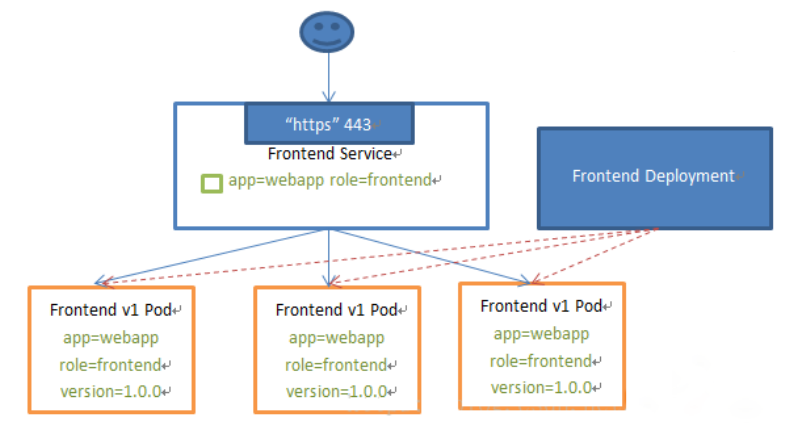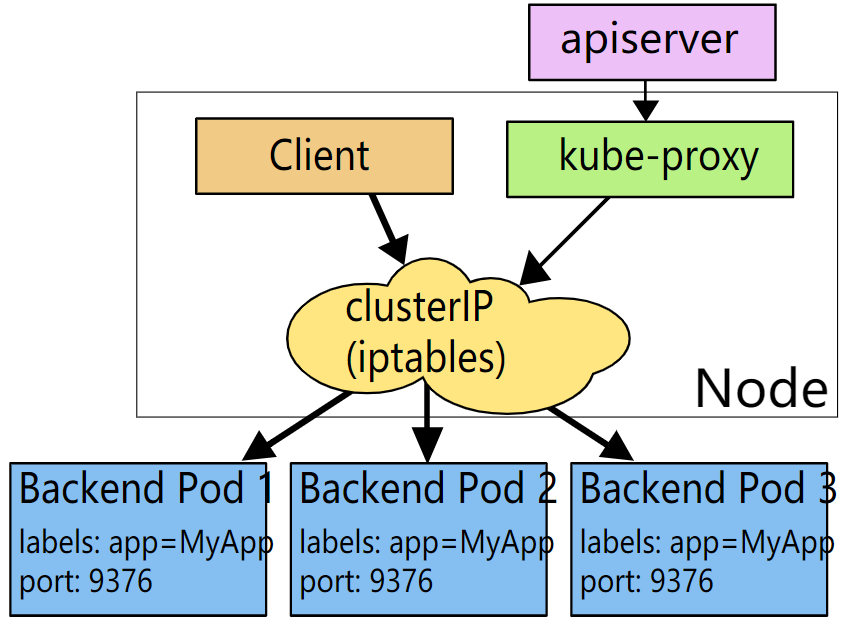Kubernetes K8S之Service服务详解与示例
K8S之Service概述与代理说明,并详解所有的service服务类型与示例
主机配置规划
| 服务器名称(hostname) | 系统版本 | 配置 | 内网IP | 外网IP(模拟) |
|---|---|---|---|---|
| k8s-master | CentOS7.7 | 2C/4G/20G | 172.16.1.110 | 10.0.0.110 |
| k8s-node01 | CentOS7.7 | 2C/4G/20G | 172.16.1.111 | 10.0.0.111 |
| k8s-node02 | CentOS7.7 | 2C/4G/20G | 172.16.1.112 | 10.0.0.112 |
Service概述
Kubernetes Service定义了这样一种抽象:逻辑上的一组 Pod,一种可以访问它们的策略 —— 通常被称为微服务。这一组 Pod 能够被 Service 访问到,通常是通过 selector实现的。
举例:考虑一个图片处理 backend,它运行了3个副本。这些副本是可互换的 —— frontend 不需要关心它们调用了哪个 backend 副本。 然而组成这一组 backend 程序的 Pod 实际上可能会发生变化,frontend 客户端不应该也没必要知道,而且也不需要跟踪这一组 backend 的状态。Service 定义的抽象能够解耦这种关联。
Service可以提供负载均衡的能力,但是使用上存在如下限制:
- 只能提供4层负载均衡能力,而没有7层功能。有时我们可能需要更多的匹配规则来转发请求,这点上4层负载均衡是不支持的、
如web访问的service服务示例图:

VIP和Service代理
在 Kubernetes 集群中,每个 Node 运行一个 kube-proxy 进程。kube-proxy 负责为 Service 实现了一种 VIP(虚拟 IP)的形式,而不是 ExternalName 的形式。
从Kubernetes v1.0开始,已经可以使用 userspace代理模式。Kubernetes v1.1添加了 iptables 代理模式,在 Kubernetes v1.2 中kube-proxy 的 iptables 模式成为默认设置。Kubernetes v1.8添加了 ipvs 代理模式。
原因如下:
- DNS 实现的历史由来已久,它不遵守记录 TTL,并且在名称查找到结果后会对其进行缓存。
- 有些应用程序仅执行一次 DNS 查找,并无限期地缓存结果。
- 即使应用和库进行了适当的重新解析,DNS 记录上的 TTL 值低或为零也可能会给 DNS 带来高负载,从而使管理变得困难。
总之就是因为有缓存,因此不合适。
userspace代理模式
这种模式,kube-proxy 会监视 Kubernetes master 对 Service 对象和 Endpoints 对象的添加和移除。 对每个 Service,它会在本地 Node 上打开一个端口(随机选择)。 任何连接到“代理端口”的请求,都会被代理到 Service 的backend Pods 中的某个上面(如 Endpoints 所报告的一样)。 使用哪个 backend Pod,是 kube-proxy 基于 SessionAffinity 来确定的。
最后,它配置 iptables 规则,捕获到达该 Service 的 clusterIP(是虚拟 IP)和 Port 的请求,并重定向到代理端口,代理端口再代理请求到 backend Pod。
默认情况下,userspace模式下的kube-proxy通过循环算法选择后端。
默认的策略是,通过 round-robin 算法来选择 backend Pod。

iptables 代理模式
这种模式,kube-proxy 会监视 Kubernetes 控制节点对 Service 对象和 Endpoints 对象的添加和移除。 对每个 Service,它会配置 iptables 规则,从而捕获到达该 Service 的 clusterIP 和端口的请求,进而将请求重定向到 Service 的一组 backend 中的某个上面。对于每个 Endpoints 对象,它也会配置 iptables 规则,这个规则会选择一个 backend 组合。
默认的策略是,kube-proxy 在 iptables 模式下随机选择一个 backend。
使用 iptables 处理流量具有较低的系统开销,因为流量由 Linux netfilter 处理,而无需在用户空间和内核空间之间切换。 这种方法也可能更可靠。
如果 kube-proxy 在 iptables模式下运行,并且所选的第一个 Pod 没有响应,则连接失败。 这与userspace模式不同:在这种情况下,kube-proxy 将检测到与第一个 Pod 的连接已失败,并会自动使用其他后端 Pod 重试。
我们可以使用 Pod readiness 探测器 验证后端 Pod 是否可以正常工作,以便 iptables 模式下的 kube-proxy 仅看到测试正常的后端。这样做意味着可以避免将流量通过 kube-proxy 发送到已知已失败的Pod。

IPVS 代理模式
在 ipvs 模式下,kube-proxy监视Kubernetes服务(Service)和端点(Endpoints),调用 netlink 接口相应地创建 IPVS 规则, 并定期将 IPVS 规则与 Kubernetes服务(Service)和端点(Endpoints)同步。该控制循环可确保 IPVS 状态与所需状态匹配。访问服务(Service)时,IPVS 将流量定向到后端Pod之一。
IPVS代理模式基于类似于 iptables 模式的 netfilter 挂钩函数,但是使用哈希表作为基础数据结构,并且在内核空间中工作。 这意味着,与 iptables 模式下的 kube-proxy 相比,IPVS 模式下的 kube-proxy 重定向通信的延迟要短,并且在同步代理规则时具有更好的性能。与其他代理模式相比,IPVS 模式还支持更高的网络流量吞吐量。
IPVS提供了更多选项来平衡后端Pod的流量。这些是:
- rr: round-robin
- lc: least connection (smallest number of open connections)
- dh: destination hashing
- sh: source hashing
- sed: shortest expected delay
- nq: never queue
注意:要在 IPVS 模式下运行 kube-proxy,必须在启动 kube-proxy 之前使 IPVS Linux 在节点上可用。 当 kube-proxy 以 IPVS 代理模式启动时,它将验证 IPVS 内核模块是否可用。 如果未检测到 IPVS 内核模块,则 kube-proxy 将退回到以 iptables 代理模式运行。

Service服务类型
Kubernetes 中Service有以下4中类型:
- ClusterIP:默认类型,自动分配一个仅Cluster内部可以访问的虚拟IP
- NodePort:通过每个 Node 上的 IP 和静态端口(NodePort)暴露服务。以ClusterIP为基础,NodePort 服务会路由到 ClusterIP 服务。通过请求
<NodeIP>:<NodePort>,可以从集群的外部访问一个集群内部的 NodePort 服务。 - LoadBalancer:使用云提供商的负载均衡器,可以向外部暴露服务。外部的负载均衡器可以路由到 NodePort 服务和 ClusterIP 服务。
- ExternalName:通过返回 CNAME 和它的值,可以将服务映射到 externalName 字段的内容(例如,foo.bar.example.com)。没有任何类型代理被创建。
需要注意的是:Service 能够将一个接收 port 映射到任意的 targetPort。默认情况下,targetPort 将被设置为与 port 字段相同的值。
Service域名格式:$(service name).$(namespace).svc.cluster.local,其中 cluster.local 为指定的集群的域名
Deployment的yaml信息
yaml文件
1 [root@k8s-master service]# pwd 2 /root/k8s_practice/service 3 [root@k8s-master service]# cat myapp-deploy.yaml 4 apiVersion: apps/v1 5 kind: Deployment 6 metadata: 7 name: myapp-deploy 8 namespace: default 9 spec: 10 replicas: 3 11 selector: 12 matchLabels: 13 app: myapp 14 release: v1 15 template: 16 metadata: 17 labels: 18 app: myapp 19 release: v1 20 env: test 21 spec: 22 containers: 23 - name: myapp 24 image: registry.cn-beijing.aliyuncs.com/google_registry/myapp:v1 25 imagePullPolicy: IfNotPresent 26 ports: 27 - name: http 28 containerPort: 80
启动Deployment并查看状态
1 [root@k8s-master service]# kubectl apply -f myapp-deploy.yaml 2 deployment.apps/myapp-deploy created 3 [root@k8s-master service]# 4 [root@k8s-master service]# kubectl get deploy -o wide 5 NAME READY UP-TO-DATE AVAILABLE AGE CONTAINERS IMAGES SELECTOR 6 myapp-deploy 3/3 3 3 31h myapp registry.cn-beijing.aliyuncs.com/google_registry/myapp:v1 app=myapp,release=v1 7 [root@k8s-master service]# 8 [root@k8s-master service]# kubectl get rs -o wide 9 NAME DESIRED CURRENT READY AGE CONTAINERS IMAGES SELECTOR 10 myapp-deploy-5695bb5658 3 3 3 31h myapp registry.cn-beijing.aliyuncs.com/google_registry/myapp:v1 app=myapp,pod-template-hash=5695bb5658,release=v1 11 [root@k8s-master service]# 12 [root@k8s-master service]# kubectl get pod -o wide --show-labels 13 NAME READY STATUS RESTARTS AGE IP NODE NOMINATED NODE READINESS GATES LABELS 14 myapp-deploy-5695bb5658-2866m 1/1 Running 2 31h 10.244.2.116 k8s-node02 <none> <none> app=myapp,env=test,pod-template-hash=5695bb5658,release=v1 15 myapp-deploy-5695bb5658-dcfw7 1/1 Running 2 31h 10.244.4.105 k8s-node01 <none> <none> app=myapp,env=test,pod-template-hash=5695bb5658,release=v1 16 myapp-deploy-5695bb5658-n2b5w 1/1 Running 2 31h 10.244.2.115 k8s-node02 <none> <none> app=myapp,env=test,pod-template-hash=5695bb5658,release=v1
curl访问
1 [root@k8s-master service]# curl 10.244.2.116 2 Hello MyApp | Version: v1 | <a href="hostname.html">Pod Name</a> 3 [root@k8s-master service]# 4 [root@k8s-master service]# curl 10.244.2.116/hostname.html 5 myapp-deploy-5695bb5658-2866m 6 [root@k8s-master service]# 7 [root@k8s-master service]# curl 10.244.4.105 8 Hello MyApp | Version: v1 | <a href="hostname.html">Pod Name</a> 9 [root@k8s-master service]# 10 [root@k8s-master service]# curl 10.244.4.105/hostname.html 11 myapp-deploy-5695bb5658-dcfw7 12 [root@k8s-master service]# 13 [root@k8s-master service]# curl 10.244.2.115 14 Hello MyApp | Version: v1 | <a href="hostname.html">Pod Name</a> 15 [root@k8s-master service]# 16 [root@k8s-master service]# curl 10.244.2.115/hostname.html 17 myapp-deploy-5695bb5658-n2b5w
ClusterIP类型示例
yaml文件
1 [root@k8s-master service]# pwd 2 /root/k8s_practice/service 3 [root@k8s-master service]# cat myapp-svc-ClusterIP.yaml 4 apiVersion: v1 5 kind: Service 6 metadata: 7 name: myapp-clusterip 8 namespace: default 9 spec: 10 type: ClusterIP # 可以不写,为默认类型 11 selector: 12 app: myapp 13 release: v1 14 ports: 15 - name: http 16 port: 80 17 targetPort: 80
启动Service并查看状态
1 [root@k8s-master service]# kubectl apply -f myapp-svc-ClusterIP.yaml 2 service/myapp-clusterip created 3 [root@k8s-master service]# 4 [root@k8s-master service]# kubectl get svc -o wide 5 NAME TYPE CLUSTER-IP EXTERNAL-IP PORT(S) AGE SELECTOR 6 kubernetes ClusterIP 10.96.0.1 <none> 443/TCP 22d <none> 7 myapp-clusterip ClusterIP 10.106.66.120 <none> 80/TCP 15s app=myapp,release=v1
查看pod信息
1 [root@k8s-master service]# kubectl get pod -o wide --show-labels 2 NAME READY STATUS RESTARTS AGE IP NODE NOMINATED NODE READINESS GATES LABELS 3 myapp-deploy-5695bb5658-2866m 1/1 Running 2 31h 10.244.2.116 k8s-node02 <none> <none> app=myapp,env=test,pod-template-hash=5695bb5658,release=v1 4 myapp-deploy-5695bb5658-dcfw7 1/1 Running 2 31h 10.244.4.105 k8s-node01 <none> <none> app=myapp,env=test,pod-template-hash=5695bb5658,release=v1 5 myapp-deploy-5695bb5658-n2b5w 1/1 Running 2 31h 10.244.2.115 k8s-node02 <none> <none> app=myapp,env=test,pod-template-hash=5695bb5658,release=v1
查看ipvs信息
1 [root@k8s-master service]# ipvsadm -Ln 2 IP Virtual Server version 1.2.1 (size=4096) 3 Prot LocalAddress:Port Scheduler Flags 4 -> RemoteAddress:Port Forward Weight ActiveConn InActConn 5 ……………… 6 TCP 10.106.66.120:80 rr 7 -> 10.244.2.115:80 Masq 1 0 0 8 -> 10.244.2.116:80 Masq 1 0 0 9 -> 10.244.4.105:80 Masq 1 0 0
curl访问
1 [root@k8s-master service]# curl 10.106.66.120 2 Hello MyApp | Version: v1 | <a href="hostname.html">Pod Name</a> 3 [root@k8s-master service]# 4 [root@k8s-master service]# curl 10.106.66.120/hostname.html 5 myapp-deploy-5695bb5658-2866m 6 [root@k8s-master service]# 7 [root@k8s-master service]# curl 10.106.66.120/hostname.html 8 myapp-deploy-5695bb5658-n2b5w 9 [root@k8s-master service]# 10 [root@k8s-master service]# curl 10.106.66.120/hostname.html 11 myapp-deploy-5695bb5658-dcfw7 12 [root@k8s-master service]# 13 [root@k8s-master service]# curl 10.106.66.120/hostname.html 14 myapp-deploy-5695bb5658-2866m
备注:如果访问失败,请参考如下文章:
「Kubernetes K8S在IPVS代理模式下svc服务的ClusterIP类型访问失败处理」
Headless Services
有时不需要或不想要负载均衡,以及单独的 Service IP。遇到这种情况,可以通过指定 Cluster IP(spec.clusterIP)的值为 “None” 来创建 Headless Service。
这对headless Service 并不会分配 Cluster IP,kube-proxy 不会处理它们,而且平台也不会为它们进行负载均衡和路由。
- 第一种:自主选择权,有时候client想自己来决定使用哪个Real Server,可以通过查询DNS来获取Real Server的信息。
- 第二种:Headless Services还有一个用处(PS:也就是我们需要的那个特性)。Headless Service对应的每一个Endpoints,即每一个Pod,都会有对应的DNS域名;这样Pod之间就可以互相访问。【结合statefulset有状态服务使用,如Web、MySQL集群】
yaml文件
1 [root@k8s-master service]# pwd 2 /root/k8s_practice/service 3 [root@k8s-master service]# cat myapp-svc-headless.yaml 4 apiVersion: v1 5 kind: Service 6 metadata: 7 name: myapp-headless 8 namespace: default 9 spec: 10 selector: 11 app: myapp 12 release: v1 13 clusterIP: "None" 14 ports: 15 - port: 80 16 targetPort: 80
启动Service并查看状态和详情
1 [root@k8s-master service]# kubectl apply -f myapp-svc-headless.yaml 2 service/myapp-headless created 3 [root@k8s-master service]# 4 [root@k8s-master service]# kubectl get svc -o wide 5 NAME TYPE CLUSTER-IP EXTERNAL-IP PORT(S) AGE SELECTOR 6 kubernetes ClusterIP 10.96.0.1 <none> 443/TCP 22d <none> 7 myapp-headless ClusterIP None <none> 80/TCP 6s app=myapp,release=v1 8 [root@k8s-master service]# 9 [root@k8s-master service]# kubectl describe svc/myapp-headless 10 Name: myapp-headless 11 Namespace: default 12 Labels: <none> 13 Annotations: kubectl.kubernetes.io/last-applied-configuration: 14 {"apiVersion":"v1","kind":"Service","metadata":{"annotations":{},"name":"myapp-headless","namespace":"default"},"spec":{"clusterIP":"None"... 15 Selector: app=myapp,release=v1 16 Type: ClusterIP 17 IP: None 18 Port: <unset> 80/TCP 19 TargetPort: 80/TCP 20 Endpoints: 10.244.2.115:80,10.244.2.116:80,10.244.4.105:80 # 后端的Pod信息 21 Session Affinity: None 22 Events: <none>
service只要创建成功就会写入到coredns。我们得到coredns IP的命令如下:
1 [root@k8s-master service]# kubectl get pod -o wide -A | grep 'coredns' 2 kube-system coredns-6955765f44-c9zfh 1/1 Running 29 22d 10.244.0.62 k8s-master <none> <none> 3 kube-system coredns-6955765f44-lrz5q 1/1 Running 29 22d 10.244.0.61 k8s-master <none> <none>
在宿主机安装nslookup、dig命令安装
yum install -y bind-utils
coredns记录信息如下
1 # 其中 10.244.0.61 为 coredns IP 2 # myapp-headless.default.svc.cluster.local 为Headless Service域名。格式为:$(service name).$(namespace).svc.cluster.local,其中 cluster.local 指定的集群的域名 3 [root@k8s-master service]# nslookup myapp-headless.default.svc.cluster.local 10.244.0.61 4 Server: 10.244.0.61 5 Address: 10.244.0.61#53 6 7 Name: myapp-headless.default.svc.cluster.local 8 Address: 10.244.2.116 9 Name: myapp-headless.default.svc.cluster.local 10 Address: 10.244.4.105 11 Name: myapp-headless.default.svc.cluster.local 12 Address: 10.244.2.115 13 14 [root@k8s-master service]# 15 ### 或使用如下命令 16 [root@k8s-master service]# dig -t A myapp-headless.default.svc.cluster.local. @10.244.0.61 17 18 ; <<>> DiG 9.11.4-P2-RedHat-9.11.4-16.P2.el7_8.6 <<>> -t A myapp-headless.default.svc.cluster.local. @10.244.0.61 19 ;; global options: +cmd 20 ;; Got answer: 21 ;; WARNING: .local is reserved for Multicast DNS 22 ;; You are currently testing what happens when an mDNS query is leaked to DNS 23 ;; ->>HEADER<<- opcode: QUERY, status: NOERROR, id: 7089 24 ;; flags: qr aa rd; QUERY: 1, ANSWER: 3, AUTHORITY: 0, ADDITIONAL: 1 25 ;; WARNING: recursion requested but not available 26 27 ;; OPT PSEUDOSECTION: 28 ; EDNS: version: 0, flags:; udp: 4096 29 ;; QUESTION SECTION: 30 ;myapp-headless.default.svc.cluster.local. IN A 31 32 ;; ANSWER SECTION: 33 myapp-headless.default.svc.cluster.local. 14 IN A 10.244.2.116 34 myapp-headless.default.svc.cluster.local. 14 IN A 10.244.4.105 35 myapp-headless.default.svc.cluster.local. 14 IN A 10.244.2.115 36 37 ;; Query time: 0 msec 38 ;; SERVER: 10.244.0.61#53(10.244.0.61) 39 ;; WHEN: Wed Jun 03 22:34:46 CST 2020 40 ;; MSG SIZE rcvd: 237
NodePort类型示例
如果将 type 字段设置为 NodePort,则 Kubernetes 控制层面将在 --service-node-port-range 标志指定的范围内分配端口(默认值:30000-32767)。
yaml文件
1 [root@k8s-master service]# pwd 2 /root/k8s_practice/service 3 [root@k8s-master service]# cat myapp-svc-NodePort.yaml 4 apiVersion: v1 5 kind: Service 6 metadata: 7 name: myapp-nodeport 8 namespace: default 9 spec: 10 type: NodePort 11 selector: 12 app: myapp 13 release: v1 14 ports: 15 - name: http 16 # 默认情况下,为了方便起见,`targetPort` 被设置为与 `port` 字段相同的值。 17 port: 80 # Service对外提供服务端口 18 targetPort: 80 # 请求转发后端Pod使用的端口 19 nodePort: 31682 # 可选字段,默认情况下,为了方便起见,Kubernetes 控制层面会从某个范围内分配一个端口号(默认:30000-32767)
启动Service并查看状态
1 [root@k8s-master service]# kubectl apply -f myapp-svc-NodePort.yaml 2 service/myapp-nodeport created 3 [root@k8s-master service]# 4 [root@k8s-master service]# kubectl get svc -o wide 5 NAME TYPE CLUSTER-IP EXTERNAL-IP PORT(S) AGE SELECTOR 6 kubernetes ClusterIP 10.96.0.1 <none> 443/TCP 22d <none> 7 myapp-nodeport NodePort 10.99.50.81 <none> 80:31682/TCP 6s app=myapp,release=v1
由上可见,类型变为了NodePort
查看ipvs信息
1 [root@k8s-master service]# ipvsadm -Ln 2 IP Virtual Server version 1.2.1 (size=4096) 3 Prot LocalAddress:Port Scheduler Flags 4 -> RemoteAddress:Port Forward Weight ActiveConn InActConn 5 ……………… 6 TCP 10.99.50.81:80 rr 7 -> 10.244.2.115:80 Masq 1 0 0 8 -> 10.244.2.116:80 Masq 1 0 0 9 -> 10.244.4.105:80 Masq 1 0 0
端口查看,可见在本地宿主机监听了相应的端口(备注:集群所有机器都监听了该端口)
1 # 集群所有机器都可以执行查看 2 [root@k8s-master service]# netstat -lntp | grep '31682' 3 tcp6 0 0 :::31682 :::* LISTEN 3961/kube-proxy
curl通过ClusterIP访问
1 # 通过ClusterIP访问 2 [root@k8s-master service]# curl 10.99.50.81 3 Hello MyApp | Version: v1 | <a href="hostname.html">Pod Name</a> 4 [root@k8s-master service]# 5 [root@k8s-master service]# curl 10.99.50.81/hostname.html 6 myapp-deploy-5695bb5658-2866m 7 [root@k8s-master service]# 8 [root@k8s-master service]# curl 10.99.50.81/hostname.html 9 myapp-deploy-5695bb5658-n2b5w 10 [root@k8s-master service]# 11 [root@k8s-master service]# curl 10.99.50.81/hostname.html 12 myapp-deploy-5695bb5658-dcfw7
curl通过节点IP访问
1 # 通过集群节点IP访问 2 [root@k8s-master service]# curl 172.16.1.110:31682 3 Hello MyApp | Version: v1 | <a href="hostname.html">Pod Name</a> 4 [root@k8s-master service]# 5 [root@k8s-master service]# curl 172.16.1.110:31682/hostname.html 6 myapp-deploy-5695bb5658-2866m 7 [root@k8s-master service]# 8 [root@k8s-master service]# curl 172.16.1.110:31682/hostname.html 9 myapp-deploy-5695bb5658-n2b5w 10 [root@k8s-master service]# 11 [root@k8s-master service]# curl 172.16.1.110:31682/hostname.html 12 myapp-deploy-5695bb5658-dcfw7 13 # 访问集群其他节点。每台机器都有LVS,和相关调度 14 [root@k8s-master service]# curl 172.16.1.111:31682/hostname.html 15 myapp-deploy-5695bb5658-dcfw7 16 [root@k8s-master service]# 17 [root@k8s-master service]# curl 172.16.1.112:31682/hostname.html 18 myapp-deploy-5695bb5658-dcfw7
访问日志查看
kubectl logs -f svc/myapp-nodeport
LoadBalancer类型示例
需要相关云厂商服务支持,这里就不表述了。
ExternalName类型示例
这种类型的Service通过返回CNAME和它的值,可以将服务映射到externalName字段的内容(例如:my.k8s.example.com;可以实现跨namespace名称空间访问)。ExternalName Service是Service的特例,它没有selector,也没有定义任何的端口和Endpoint。相反的,对于运行在集群外部的服务,它通过返回该外部服务的别名这种方式提供服务。
具体使用参见:「Kubernetes K8S之Pod跨namespace名称空间访问Service服务」
yaml文件
1 [root@k8s-master service]# pwd 2 /root/k8s_practice/service 3 [root@k8s-master service]# cat myapp-svc-ExternalName.yaml 4 apiVersion: v1 5 kind: Service 6 metadata: 7 name: myapp-externalname 8 namespace: default 9 spec: 10 type: ExternalName 11 externalName: my.k8s.example.com
启动Service并查看状态
1 [root@k8s-master service]# kubectl apply -f myapp-svc-ExternalName.yaml 2 service/myapp-externalname created 3 [root@k8s-master service]# 4 [root@k8s-master service]# kubectl get svc -o wide 5 NAME TYPE CLUSTER-IP EXTERNAL-IP PORT(S) AGE SELECTOR 6 kubernetes ClusterIP 10.96.0.1 <none> 443/TCP 21d <none> 7 myapp-externalname ExternalName <none> my.k8s.example.com <none> 21s <none>
由上可见,类型变为了ExternalName
宿主机dig命令安装
yum install -y bind-utils
coredns记录信息如下
1 # 其中 10.244.0.61 为 coredns IP 2 # myapp-externalname.default.svc.cluster.local 为Service域名。格式为:$(service name).$(namespace).svc.cluster.local,其中 cluster.local 指定的集群的域名 3 ##### 通过 nslookup 访问 4 [root@k8s-master service]# nslookup myapp-externalname.default.svc.cluster.local 10.244.0.61 5 Server: 10.244.0.61 6 Address: 10.244.0.61#53 7 8 myapp-externalname.default.svc.cluster.local canonical name = my.k8s.example.com. 9 ** server can't find my.k8s.example.com: NXDOMAIN 10 11 [root@k8s-master service]# 12 ##### 通过 dig 访问 13 [root@k8s-master service]# dig -t A myapp-externalname.default.svc.cluster.local. @10.244.0.61 14 15 ; <<>> DiG 9.11.4-P2-RedHat-9.11.4-16.P2.el7_8.6 <<>> -t A myapp-externalname.default.svc.cluster.local. @10.244.0.61 16 ;; global options: +cmd 17 ;; Got answer: 18 ;; WARNING: .local is reserved for Multicast DNS 19 ;; You are currently testing what happens when an mDNS query is leaked to DNS 20 ;; ->>HEADER<<- opcode: QUERY, status: NOERROR, id: 39541 21 ;; flags: qr aa rd; QUERY: 1, ANSWER: 1, AUTHORITY: 0, ADDITIONAL: 1 22 ;; WARNING: recursion requested but not available 23 24 ;; OPT PSEUDOSECTION: 25 ; EDNS: version: 0, flags:; udp: 4096 26 ;; QUESTION SECTION: 27 ;myapp-externalname.default.svc.cluster.local. IN A 28 29 ;; ANSWER SECTION: 30 myapp-externalname.default.svc.cluster.local. 30 IN CNAME my.k8s.example.com. 31 32 ;; Query time: 2072 msec 33 ;; SERVER: 10.244.0.61#53(10.244.0.61) 34 ;; WHEN: Wed Jun 03 23:15:47 CST 2020 35 ;; MSG SIZE rcvd: 149
ExternalIP示例
如果外部的 IP 路由到集群中一个或多个 Node 上,Kubernetes Service 会被暴露给这些 externalIPs。通过外部 IP(作为目的 IP 地址)进入到集群,打到 Service 端口上的流量,将会被路由到 Service 的 Endpoint 上。
externalIPs 不会被 Kubernetes 管理,它属于集群管理员的职责范畴。
根据 Service 的规定,externalIPs 可以同任意的 ServiceType 来一起指定。在下面的例子中,my-service 可以在【模拟外网IP】“10.0.0.240”(externalIP:port) 上被客户端访问。
yaml文件
1 [root@k8s-master service]# pwd 2 /root/k8s_practice/service 3 [root@k8s-master service]# cat myapp-svc-externalIP.yaml 4 apiVersion: v1 5 kind: Service 6 metadata: 7 name: myapp-externalip 8 namespace: default 9 spec: 10 selector: 11 app: myapp 12 release: v1 13 ports: 14 - name: http 15 port: 80 16 targetPort: 80 17 externalIPs: 18 - 10.0.0.240
启动Service并查看状态
1 [root@k8s-master service]# kubectl apply -f myapp-svc-externalIP.yaml 2 service/myapp-externalip created 3 [root@k8s-master service]# 4 [root@k8s-master service]# kubectl get svc -o wide 5 NAME TYPE CLUSTER-IP EXTERNAL-IP PORT(S) AGE SELECTOR 6 kubernetes ClusterIP 10.96.0.1 <none> 443/TCP 22d <none> 7 myapp-externalip ClusterIP 10.107.186.167 10.0.0.240 80/TCP 8s app=myapp,release=v1
查看ipvs信息
1 [root@k8s-master service]# ipvsadm -Ln 2 IP Virtual Server version 1.2.1 (size=4096) 3 Prot LocalAddress:Port Scheduler Flags 4 -> RemoteAddress:Port Forward Weight ActiveConn InActConn 5 ……………… 6 TCP 10.107.186.167:80 rr 7 -> 10.244.2.115:80 Masq 1 0 0 8 -> 10.244.2.116:80 Masq 1 0 0 9 -> 10.244.4.105:80 Masq 1 0 0 10 ……………… 11 TCP 10.0.0.240:80 rr 12 -> 10.244.2.115:80 Masq 1 0 0 13 -> 10.244.2.116:80 Masq 1 0 0 14 -> 10.244.4.105:80 Masq 1 0 0
curl访问,通过ClusterIP
1 [root@k8s-master service]# curl 10.107.186.167 2 Hello MyApp | Version: v1 | <a href="hostname.html">Pod Name</a> 3 [root@k8s-master service]# 4 [root@k8s-master service]# curl 10.107.186.167/hostname.html 5 myapp-deploy-5695bb5658-n2b5w 6 [root@k8s-master service]# 7 [root@k8s-master service]# curl 10.107.186.167/hostname.html 8 myapp-deploy-5695bb5658-2866m 9 [root@k8s-master service]# 10 [root@k8s-master service]# curl 10.107.186.167/hostname.html 11 myapp-deploy-5695bb5658-dcfw7
curl访问,通过ExternalIP
1 [root@k8s-master service]# curl 10.0.0.240 2 Hello MyApp | Version: v1 | <a href="hostname.html">Pod Name</a> 3 [root@k8s-master service]# 4 [root@k8s-master service]# curl 10.0.0.240/hostname.html 5 myapp-deploy-5695bb5658-2866m 6 [root@k8s-master service]# 7 [root@k8s-master service]# curl 10.0.0.240/hostname.html 8 myapp-deploy-5695bb5658-dcfw7 9 [root@k8s-master service]# 10 [root@k8s-master service]# curl 10.0.0.240/hostname.html 11 myapp-deploy-5695bb5658-n2b5w
相关阅读
1、Kubernetes K8S在IPVS代理模式下svc服务的ClusterIP类型访问失败处理
2、Kubernetes K8S之Pod跨namespace名称空间访问Service服务
3、kubernetes学习Service之headless和statefulSet结合
4、linuxea:kubernetes Headless Service无头服务
———END———
如果觉得不错就关注下呗 (-^O^-) !






 浙公网安备 33010602011771号
浙公网安备 33010602011771号